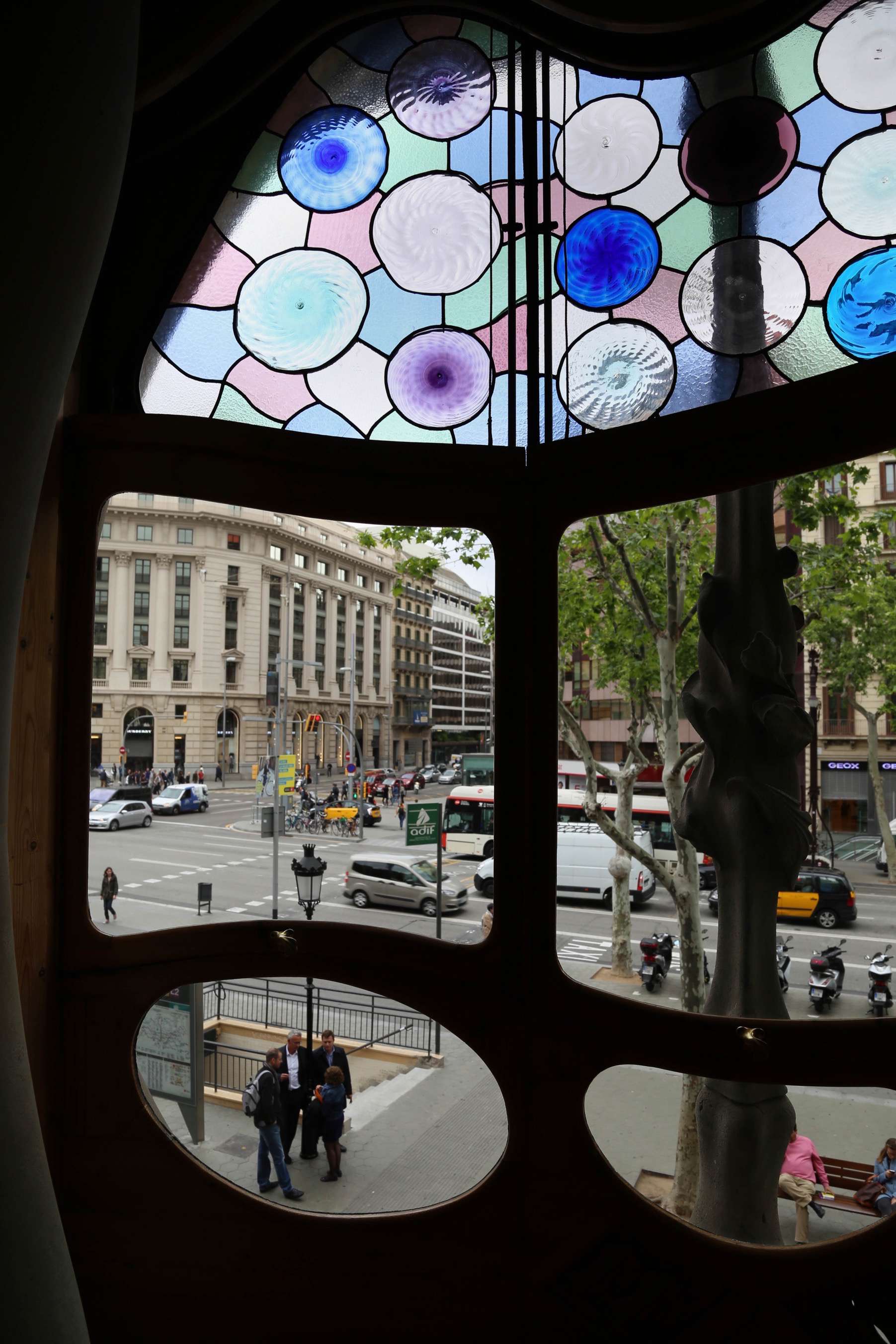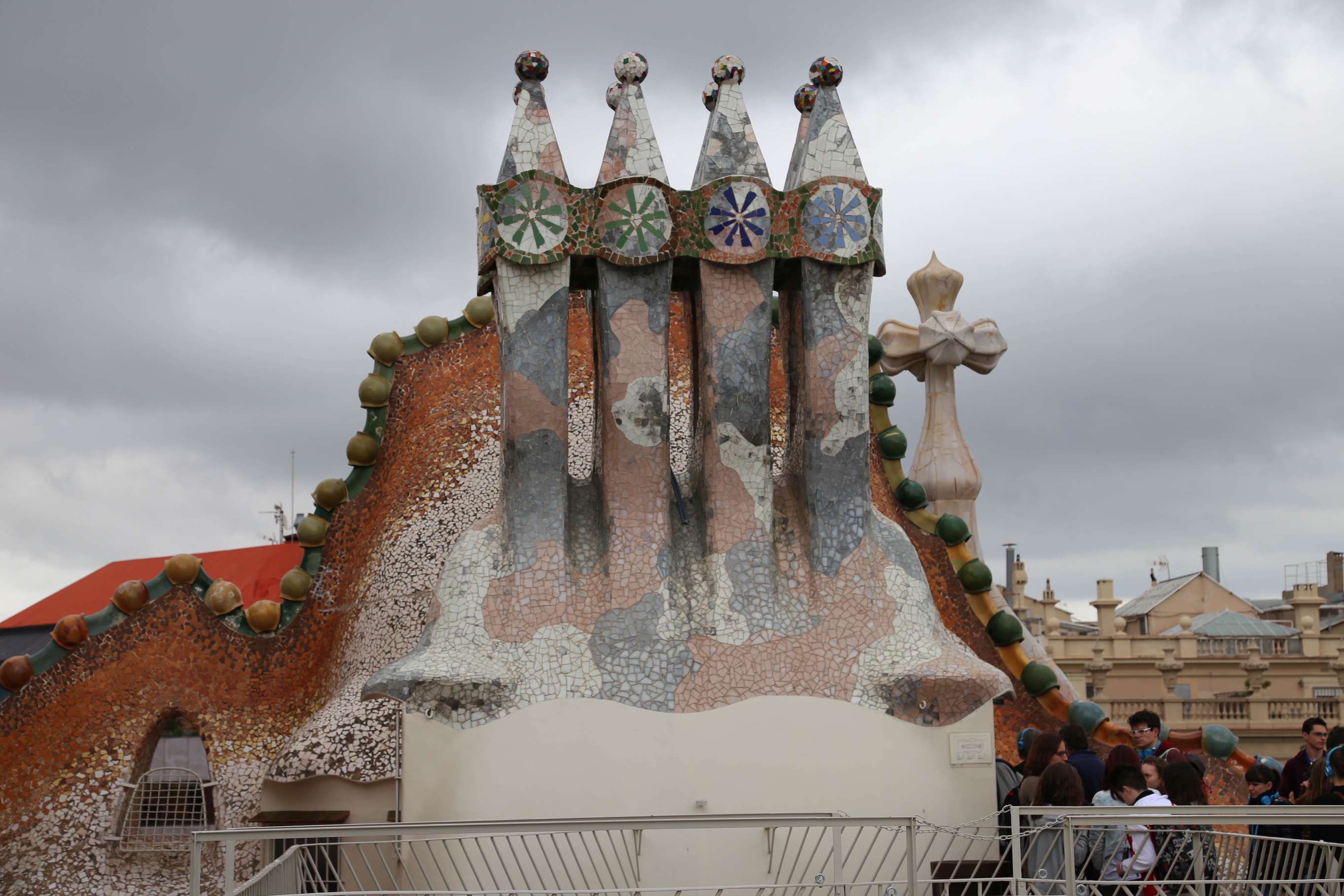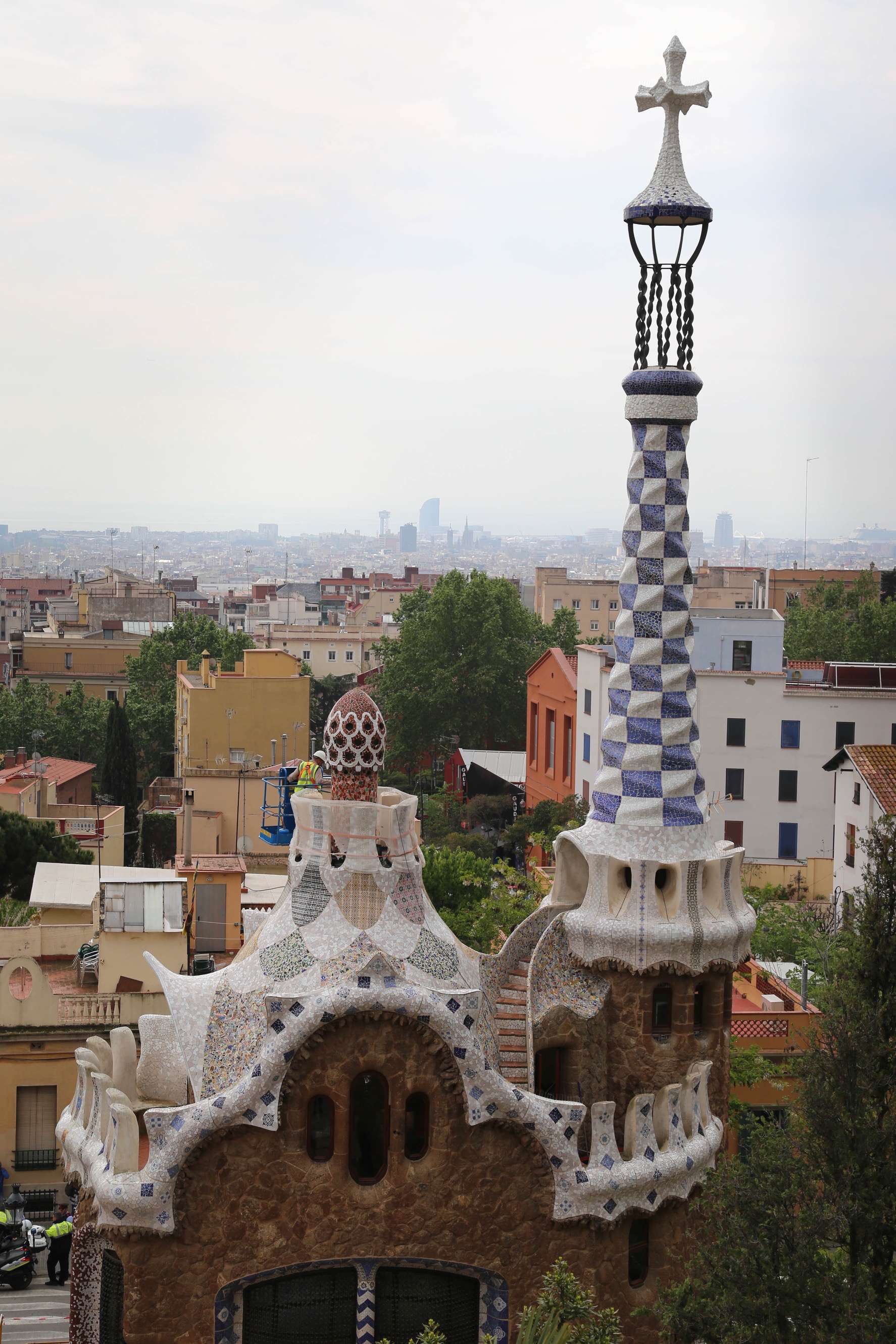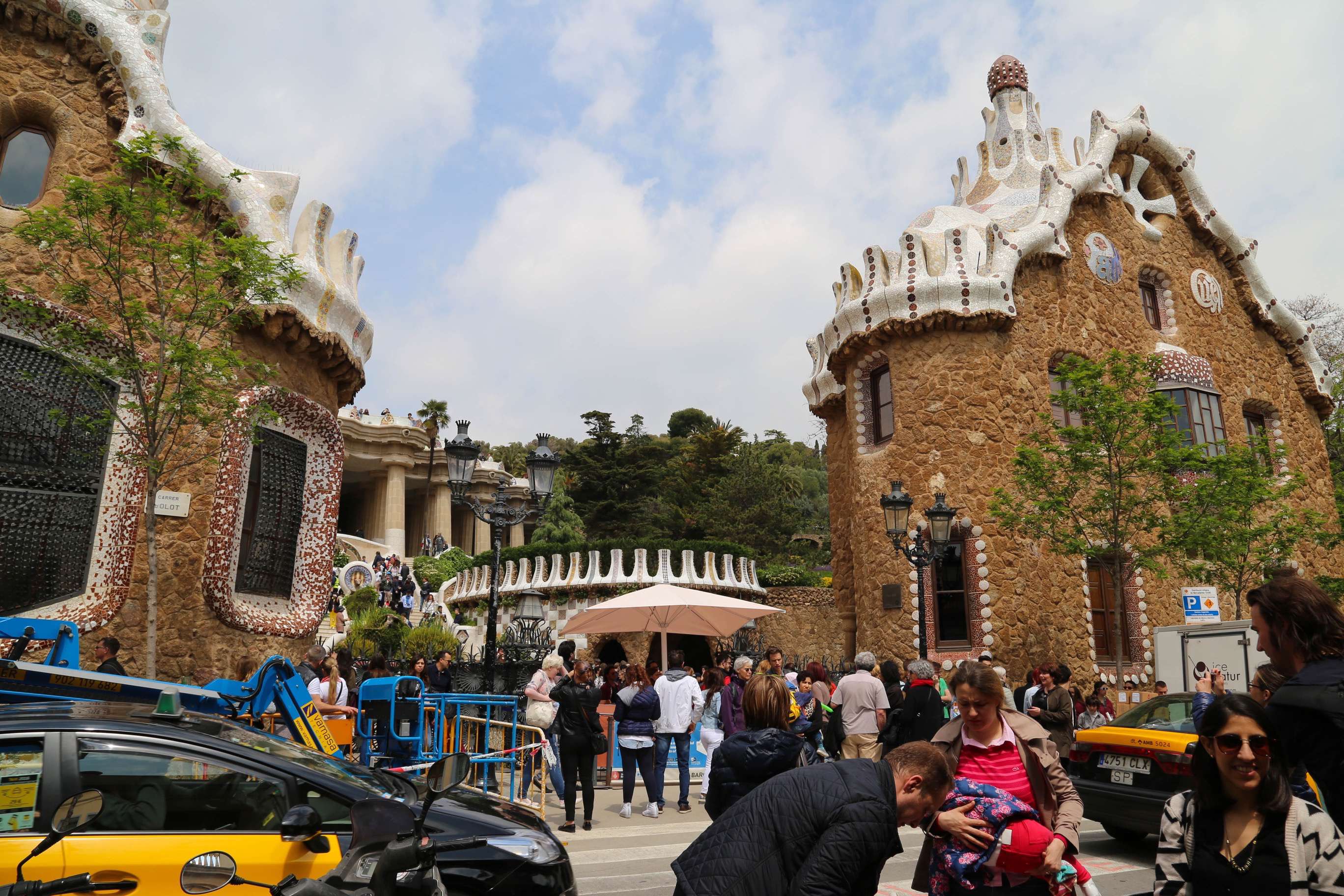
Casa Batlló Is a Barcelona treasure and this project designed by the famed architect is a UNESCO World Heritage Site.
The architecture of Antoni Gaudi is eye candy for the imagination. Creativity, inventiveness, form, function, visual daring, grandeur, and playfulness merge into structures as dramatically pleasing as they are superbly functional. And despite Gaudi’s immense talents he was a pious and humble man. His work is so impressive that seven of Gaudi’s projects, all in Barcelona, have been designated UNESCO World Heritage Sites.

The interior space of Casa Batlló is a visual feast.

This was once part of the apartment of the Batlló family designed by Gaudi, demonstrating his immense talent as one of the world’s great architects.
Two of those landmarks, one a completed project and the other a dream not fully realized, are highlighted here.

Even the same space at Casa Batlló can appear different. Here, looking up, the tiles are a lighter shade, but…

… when looked at from above, they take on a deeper, cooler blue.
Casa Batlló may well be the most notable building renovation in history. Originally constructed in 1877 along Barcelona’s Passeig de Garcia it was an uninspiring multistory building but was nonetheless in a highly desirable location. The owner, Josep Batlló, a Barcelona textile magnate, wanted to raze the structure and replace it with something entirely new and dramatic; he wanted to attract attention. Batlló and his wife, Amalia, turned to Gaudi based on another of his Barcelona projects that had tongues wagging. When Batlló hired Gaudi, the couple wisely gave the architect free rein.

For Gaudi, a doorway is more than a portal to another space, it is an opportunity to engage one’s mind.

The windows at Casa Batlló afford generous views of Passeig de Gracia.

Casa Batlló is a very popular attraction in Barcelona, and visitors would do well to arrive early as crowds and noise can be distracting.
Gaudi’s first piece of advice would save Batlló time and money – don’t tear down the building – renovate it. And renovate Gaudi did. In a few short years, from 1904 through 1906, Gaudi transformed the building and added additional floors, while managing to flummox both Barcelona city officials and neighbors along Passeig de Gracia because the design was initially judged to be appalling.

A window cleaner at work, in preparation for the day’s visitors at Casa Batlló.
The result is a timeless masterpiece, and even more than a century later, it is an ode to innovation. Gaudi discarded rigid notions of straight lines, square windows and right angles. Instead, he lavished Casa Batlló with an abundance of curves, swirls, vivid colors, delightful views and a riot of colors that burst forth. You do not stand in this space but rather you become immersed in it. Visitors find wonder in the smallest of details, and the House of Bones, as locals refer to it, was named a UNESCO World Heritage Site in 2005.

Gaudi took advantage of every element at Casa Batlló to satisfy the desires of his clients — be bold — and even a staircase has its own personality.

From another angle the staircase at Casa Batlló looks more lifelike than utilitarian.

Some of the apartments in Casa Batlló are now offices, and here a group has gathered for a meeting.
The first floor of Casa Batlló was an apartment for Josep and Amalia and at more than 7,500 square feet in size it provided ample room for the couple and their five children. Apartments on the floors above were rented out. The family lived at Casa Batlló for decades, though Josep died in 1934. Amalia and her children remained there until she died in 1940, whereupon the children managed the building until 1954, when it was sold. It has since been resold and in 2002 it was opened for tours to the public. Casa Batlló is a top tourist attraction in Barcelona and a must-see for architecture and design aficionados.

Gaudi paid close attention to even the smallest details, making sure that every element at Casa Batlló would be appreciated and create an effect.

The distinctiveness of the rear of Casa Batlló stands out, when compared with the other buildings nearby.

Throughout Casa Batlló, and at other projects by Gaudi, the use of broken tiles, or trencadis, add spots of color, like this element.
Nearly every element at Casa Batlló is special, so to suggest any one thing is distinctive misses the point. The building feels as if it possesses a life of its own, from the massive dragon-look of the brightly colored tile roof, the vivid colors and tile work, and smokestacks on the roof that appear to be sentries standing guard. Under the roof is a loft that includes 60 arches curved like a ribcage, evoking the feel of being inside the roof’s dragon. Throughout the building Gaudi uses broken tiles, known as trencadis or pique assiette, to decorate spots with a mosaic of colors.

The ridge line of the roof at the front of Casa Batlló shows what might appear to be dragon’s back and the cross element some believe was an allegory for St. George — the dragon slayer — and also the patron saint of Catalonia.

Everything at Casa Batlló appears to have a purpose, and the chimneys appear to be guards on sentry duty.

As simple as they appear, the chimneys were designed by Gaudi to prohibit gusts of wind from forcing smoke back into the fireplaces below.

Underneath the roof is a passage of 60 arches, evoking a sense of passing along a dragon’s rib cage, another unifying theme of Gaudi’s brilliant design.

An element as simple as a laundry room in an upper level of Casa Batlló is designed with beauty and utility.

This is now an exhibition space where visitors can learn more about Casa Batlló, but originally it was used for storage for those who once lived there.

Gaudi also designed furniture for Casa Batlló, and these replicas are for sale in the gift shop.
One visit to Casa Batlló and the way you look at living spaces will never be the same.

On the outside wall, the name Güell announces the name of what has become one of the most beloved parks in the world.

Parc Güell would have been a one-of-a-kind enclave of homes that were never built, but lucky for the world, Gaudi finished the park.

A group of school children pose for a photo by the dragon, or salamander. This is the symbol of Parc Güell and may be the most photographed reptile in the world.
It was Gaudi’s work at Parc Güell that caught the eye of Batlló. Like Batlló, Eusebi Güell was a Barcelona textile industrialist (and it is possible the two men knew each other). Güell had become interested in Gaudi based on his design of the Spanish Pavilion at the Paris World’s Fair in 1878.

The Hypostyle, top, was planned to be an area of shops and kiosks for those living at Parc Güell. From a distance it appears to be a fairly straightforward functional space, but looks are deceiving.

An interesting design aspect of the Hypostyle is that outside columns are at a slight angle, with the inside columns vertical. And notice how the base of the columns are festooned with white mosaic tiles.

In addition, some of the Hypostyle supports the large open space above, surrounded by benches and mosaics of tile work known as trencadis.

There is intricacy everywhere you look at Parc Güell, including the mosaic and grill work of the window, right, at the Caretaker’s waiting area, now Visitors’ Centeer.
And Gaudi and Güell shared a number of interests. Both were devout Catholics, they were fiercely proud of their Catalan heritage, they both shared utopian ideals, and the two men had a deep love of nature.

Gaudi and Güell loved nature and wanted the park to convey that as much as possible. The Caretaker’s waiting area peeks through in the background.
Güell’s concept was to convert his family estate into a high end housing community of 60 villas sited on triangular lots in the hills above Barcelona. A selling feature would be the location up in fresh air, far away from the smokestacks of industrial Barcelona. The park and its amenities would offer tranquility from the hustle and bustle of the city and the homes would have the newest amenities and comforts.

Another innovative design element developed by Gaudi was the viaduct walkway. It was meant as a place where people could stroll in comfort and quiet.
Gaudi labored at Parc Güell from 1900 through 1914 (while at the same time working on other projects like Casa Batlló). The first step for the Güell commission was to design and build the park and grounds. In the end, Güell’s vision of a utopian enclave never came to be (only two homes were built on the property), but Gaudi’s park would become one of the most famous in the world.

This house was the only only other home built on at Parc Güell. It was purchased by Gaudi, who never married, and he and his family lived in it. The villa is now a museum about Gaudi and his work.
Like much of Gaudi’s awe inspiring work, the architect cast aside normal rules that lines must be straight or that angles must be “right”. Even though Gaudi had nearly 42.5 acres to work with, he employed innovative techniques to maximize land use, create as much natural space as possible and to reduce the footprint of vehicle traffic that would impact the site.

Parc Güell is less than 45 acres in size, and this villa, left, now an elementary school, was Güell’s home. Part of the Hypostyle is visible to the right.
There are four entrances into Parc Güell and the most popular is at the gate on the south side that is flanked by two buildings, known as the Caretaker’s House with its adjacent waiting area. And located in the only villa constructed at Parc Güell is what now houses a museum about Gaudi and his work, the villa was once owned by Gaudi. What is now a school on the west side of the park is Güell’s former mansion.

The Caretaker’s house, left, was designed by Gaudi and is the only other home that was built on Parc Güell.
Among the more popular features at Parc Güell are the municipal garden, the colonnaded pathways, the Hypostyle Room (which would have housed stores and shops for the community), and the Dragon Stairway. The predominantly blue mosaic dragon, or salamander, is the symbol of Parc Güell and may be the most photographed dragon in the world.

This lovely world traveler poses for a photo next to the salamander that is symbol of Parc Güell.

Tourists crowd around the salamander to grab a quick photo. The blue-hued mosaic reptile is one of the most popular spots in all of Parc Güell.
Upon Güell’s death in 1918, the dream of a utopian community of upscale villas also passed into memory. In 1926 the City of Barcelona opened the park to the public, and in 1984 it was designated a UNESCO World Heritage Site. Parc Güell continues to be a wildly popular attraction, drawing millions of visitors each year.

A technician pauses as she works on maintaining and restoring a portion of the trencadis that adorns the benches on the public plaza of Parc Güell.

Parc Güell’s location up in the hills of Barcelona offers sweeping views of the city below.
In recent years Barcelona’s growing popularity as a travel destination is being crushed by the weight of its own success. Crowds, intrusive selfie sticks, long lines of people, and a growing lack of patience – from locals as well as tourists – is putting a strain on attractions like Casa Batlló, Parc Güell and other venues in the city. As an example, Parc Güell is limiting access to some areas of the park by requiring visitors to purchase tickets, noisy crowds can drown out the tranquility of the park’s nature, and vendors hawking trinkets detract from the experience. Barcelonan residents are becoming less tolerant of foreign visitors, and in some cases locals have voiced disapproval with the crowds and some of the misbehavior. City officials continue to consider and adopt strategies to protect their treasures and enable Barcelona to remain a livable city.

The Caretaker’s house, right, is viewed from the stairs near the salamander at Parc Güell.

On the roof of the Caretaker’s waiting area, ablaze with tile work, a set of stairs is revealed, leading to the spire.
Despite all the pressures, the incredible works of Antoni Gaudi prove the enduring brilliance of one man’s vision and his lasting impact on one of the world’s great cities.

The crowds and congestion both inside and outside of Parc Güell are becoming of increasing concern to Barcelona officials as well as those who live near the park.
For learn more about Antoni Gaudi and his work, click over to these websites:
